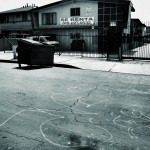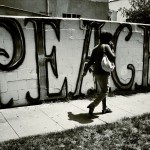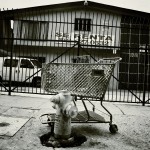-
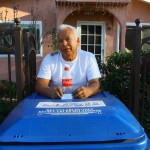
-
Ignacio Ramirez
-
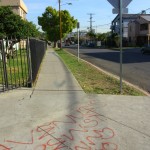
-
Graffiti on Drew Street
I spent some time today on Drew Street in the Glassell Park neighborhood in northeast LA.
This three three-block stretch was once one of the most dangerous spots in the city. It was essentially a closed society, and had as much to do with a Mexican village as with LA itself. It was inhabited by dozens of families from the town of Tlalchapa, Guerrero in the Tierra Caliente, a particularly violent part of southern Mexico.
Drew was the landing strip for immigrants from Tlalchapa, but even back in the town, Drew came to be known as the “Barrio Bajo” (the Low Neighborhood), as all those with aspirations came and left, leaving behind those with other intentions.
A few in particular grew up to run the drug trade on the street and their children grew into gang members. By the middle of the last decade, Drew Street was like a garrison state in some ways, where the folks on the street ran things, dense apartments provided places to hide and watch for police, and no one could move in who didn’t have some connection to the gang families in the area. (I know one person who had his rent money refunded by the gang to get him to move.) One family in particular was the shot-caller: the Leon-Reals, and especially the matriarch, Maria “La Chata” Leon.
I wrote about the family and the street after one of the family members, Danny Leon, was killed in a shootout with cops in 2008.
In the following years, the gang on Drew Street was the focus of a RICO indictment and a gang injunction. Many went to prison, including La Chata. One of the Leon Reals, Francisco, turned state’s evidence. The city seized several properties and, in an attempt at a kind of exorcism, destroyed La Chata’s house, which had a large satellite dish and was thus known as the Satellite House. It’s now a community garden.
Things are very different now on Drew. The gang still has some presence – it writes on trees and sidewalks, but by and large things are quiet, even sweet, on Drew.
Adan, an ice cream vendor, says he hasn’t had any trouble in the three years he’s been driving the street. The community garden seems full. There are no kids in hoodies lurking by the cars. The major apartment buildings are without graffiti.
I spoke with Ignacio Ramirez, who bought in 1968 and watched as the street descended into hell. He woke up to a body one morning, and a bullet hole in his door another.
He now owns four properties on Drew, even buying one of the houses the city seized due to drug activity.
“It’s getting there,” he said.



